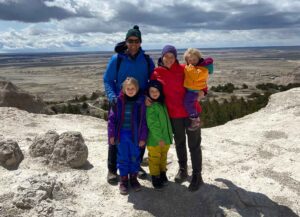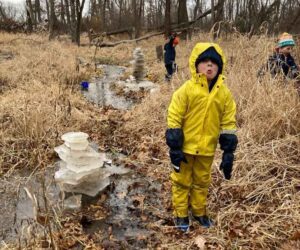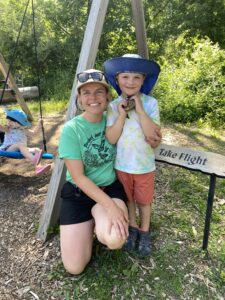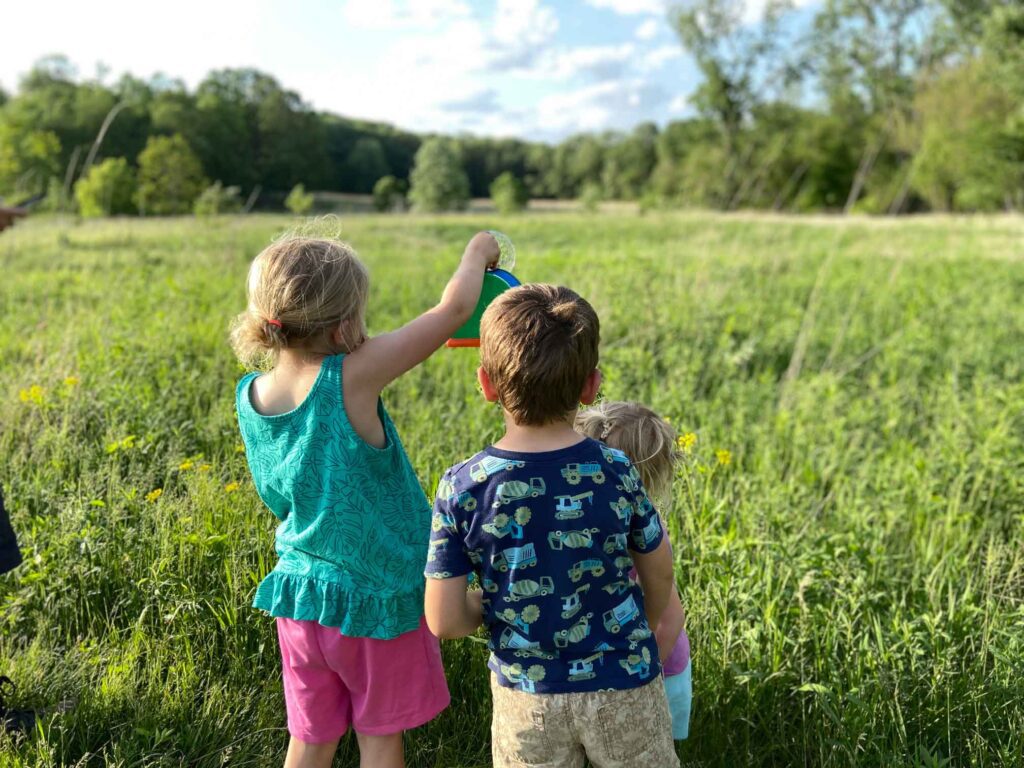Marissa and Daniel Haas began sending their children to Indian Creek Nature Center’s outdoor immersive educational programs as early as they could. After enrolling their children in Fresh Air Academy Daytime and Creekside Forest School, the family has gotten to know the land, staff and volunteers well and have become part of the Indian Creek Nature Center community. Below, Marissa shares a touching story about how her son’s experience as a Creekside Forest School student reminded her of a saying that speaks true to the Nature Center’s mission. “There is no bad weather, just bad clothing.”

It was a late autumn morning, and it was pouring rain, the kind of drenching rain that would send even a fish running for cover. The water was coming down in sheets, overwhelming our gutters and obscuring the view out our window into a blurry muddle of brown and gray. The “fall colors” were long gone, with the exception of the orange pumpkins rotting on our front steps, now looking even more pitiful in the downpour.
I walked slowly down the stairs with a sigh. It was going to be a long day keeping my kids occupied inside. My five-year-old son, Otto, had beat me downstairs and was now perched on the couch, silently gazing out our front window. After a moment of soaking it in, he turned to me, and said “Wow, Mom, what a beautiful day!” His sincerity stopped me in my tracks. Were we seeing the same thing? After another glance out the window, it occurred to me that we were, and also weren’t, and I suspected that I had his teachers at the Creekside Forest School to thank for that.
Only a month or two later, my suspicions were confirmed as I was dropping Otto off for the afternoon session of preschool. It was well below freezing and the wind was fierce and biting, ripping straight through the fleece jacket I’d thrown on in my hurry to get out the door. Unlike me, Otto was dressed for the occasion, layered up like an onion as his teachers had advised in the morning message they sent to parents each day. As I shuddered and squinted in the icy wind, I felt a little bad leaving Otto out here. At least I could run back to my warm car in a minute.

But Otto’s teachers didn’t shuffle him off indoors that day. Instead, we were greeted outside with a warm smile by one of his teachers, Morgan, also dressed like an onion, who was quick to remark on how crisp everything looked in the bright sunshine. Her cheerfulness was contagious. Without an ounce of negativity, she commented that it would be a perfect day to explore Bena Brook, protected from the wind by the trees, and see if it had frozen yet. Like every day, she and her fellow teachers, Nicole and Marcy, had customized the day’s activities to embrace, or at least work in concert with, the weather rather than avoid it.
This positive attitude towards the outdoors, towards the weather, was not a one-off Pollyanna approach to challenging conditions, and is not unique to Morgan or even Creekside Forest School. Our family has encountered this authentic positivity towards nature over and over in our interactions with the staff and volunteers at Indian Creek Nature Center, from the educators leading Fresh Air Academy with our oldest daughter, to the naturalists leading hikes and educational programs, to the volunteers and staff greeting us at the front desk.
And Indian Creek’s enthusiasm stems far beyond a can-do approach to “bad” weather – it’s at the Nature Center that I’ve seen staff and volunteers become giddy about spotting the first ephemerals of spring, gush with excitement about a hognose snake sunning itself by the building, or admire with sheer delight the dainty eyelashes of songbirds made visible in magnified photos. At ICNC, I’ve encountered full-grown adults lying flat on the ground to get a closer look at a mother wolf spider carrying hundreds of babies on her back, or squealing about catching a frog with just as much zeal as the four-year-olds around them. When snowmelt and rain flooded trails, Indian Creek syrupers collected maple sap by boat. After the 2020 derecho devastated the Nature Center’s grounds, the Indian Creek community rightfully mourned the loss. But then, in perhaps an ultimate test of optimism, they found a silver lining in the disaster, seeing an opportunity to intentionally diversify the trees planted on the property.

It’s not that the people at Indian Creek Nature Center are oblivious of the bad news out there in regards to nature, and there’s plenty of it. With expert naturalists, scientists, and lifelong nature enthusiasts among their staff and volunteers, they are well aware of the perils facing our planet and are actively involved in solutions. Yet, they also seem keenly aware of something that is easy to lose sight of amidst the doom: that before we will care, before we will take meaningful action to protect nature, we must first love it.
This curiosity about and appreciation of the natural world is integrated into ICNC’s myriad of programming opportunities and, in addition to the Nature Center’s abundant natural spaces, is what draws in community members and families like ours to experience and fall in love with nature over and over again. It has inspired our whole family to get out there, (almost) whatever the weather, to experience nature first-hand and learn more about its amazing, weird, and often surprising ways. Consequently, it has also inspired our family to take action – exploring, appreciating, protecting, and even rebuilding natural and wild areas, both close to home and beyond.
On that cold, rainy, late autumn day, I didn’t succeed at keeping my kids occupied inside all day. It turns out that downpours can make for some incredible mud, and my son tipped me off to a secret hill tucked away in the woods behind the Nature Center’s prairie that is prime for mud sliding. As my kids and I slid down that hill, covered in mud and laughing until our lungs hurt, I could finally see what my son had seen all along – it was, in fact, a beautiful day.

